There is no doubt the internet is advancing rapidly, and with the rise of AI content creation tools like ChatGPT, Jasper, etc, it’s getting harder to distinguish which piece was written by a human being.
Today, millions of users have turned to different AI platforms and tools to generate different texts, from jokes to stories, business emails, and blog posts. Even more concerning, students are now using the tools to do their homework.
With the recent Google algorithm update E-E-A-T to counter spammy content and reward quality content, it will be interesting to see how things pan out.
However, if you’re not Google, how can you tell whether AI wrote a text?
By reading a piece of content online, it might not be easy to differentiate human-written content from machine generated ones.
However, some specific qualities and patterns can be used to identify text written by artificial intelligence tools. Among them include grammatical issues, repetitive words, lack of context, and coherence.
In this article, we will explore several techniques for recognizing AI-generated writing and present examples to assist you in differentiating between human-written and AI-generated content.
Let’s dive in and explore.
What is AI-generated content?
AI content is often used to describe written material such as blog posts, marketing copy, and articles generated by a machine. However, it’s worth noting that the tools don’t work in isolation. They require human input, such as summaries, prompts, or parameters to give an output. The input can be a term, phrase, or brief paragraph, depending on the desired results the user wants.
The goal of AI-generated content is to minimise the need for human intervention in content creation.
Why is it important to detect AI content?
The ability to tell whether the information was created using a language model or an AI text tool is highly relevant to businesses, governments, and educational institutions.
Without the AI detection tools, it would be easy for students or workers to generate and pass off these resources as their own. Besides in the academic realm, this would amount to cheating.
It’s also important for online publishers to ensure that their writers aren’t passing off AI-generated content as hand written because search engines like Google claim to detect and penalise it.
But what are some of the signs that a piece of text was generated using an AI tool?
Signs of AI-generated text
There are various indicators that text is bot-generated. In this section, we’ll explore these indicators and show how they can be utilised to detect writing created by artificial intelligence. They include:
Lack of coherence
A lack of coherence or consistency is a possible indicator of AI-generated content. This suggests that the content may not make sense when read. AI-generated content is often created by stringing together words and sentences without considering the intended context.
For instance, a text written by AI can contain extraneous details or jump from one idea to another without a logical transition.
There’s also the possibility that the AI-generated text will use concepts and terminology that are either irrelevant to the context at hand or are used in an illogical manner.
Repetition
AI algorithms are often designed to follow a particular pattern. If you’re reading a piece of content that sounds formulaic, it might have been generated using AI tools.
For example, if each sentence starts the same way then that’s a red flag that it’s AI generated:
“AI-generated text is often repetitive. AI-generated text can be spotted if you’re familiar with a few red flags. AI-generated text often includes unnaturally repetitive sentence structures. AI-generated text lacks variation. AI-generated text often fails to follow the conventions of natural human language.”
Obviously AI-generated text, bearing all the hallmarks.
Grammatical Errors
Grammar errors are another red flag that AI could have generated the text. Incorrect punctuation, capitalisation, verb conjugation, or word choices are all possible grammatical errors in AI-generated text.
Lack of current information
AI tools are not privy to current data. They rely on the already existing information for the yester years. For instance, I asked Jasper “What is the human total population? See screen shot below.
According to the tool, Indian population is it 1.3 billion people, which is pretty close, but if you counter check the population as of 2021 as 1.4 billion people.
Therefore if you were to rely on tht tool as a source of information, then your analysis will be skewed.
Missing Human Touch
Perhaps this is one of the easiest ways to spot machine-generated content. Bot-written content lacks emotions and creativity compared to human-written content. Humans can infuse feelings and creative language in their pieces, whereas bots can only write sentences that may or may not be useful and engaging to the readers by predicting the next patterns in the text.
Overly formal or generic Language
In many cases, AI-generated content seems too formal or general since the underlying algorithms can’t grasp the complexities of human language. This can cause the produced text to sound automated and disjointed since the algorithms follow the rules and patterns they were taught.
Additionally, the data used to train AI models is too focused on formal, technical language rather than a broad spectrum of other types. The result might be artificially created writing that sounds too stiff and lacks the simplicity of natural speech.
Now that you’re familiar with the patterns you can look out for to differentiate AI texts, let’s look at some AI-detection tools.
Abundance of exclamation marks
On the subject of overly formal text, text that is written by AI often includes exclamation marks in the most innappropriate positions.
Most experienced writers will be conservative about the use of exclamation marks, but AI like GPT-3 will sprinkle them liberally, often including multiple !s per paragraph in lieu of perfectly acceptable full stops.
Our comprehensive funeral care packages offer something for everyone, ensuring your loved one’s passing is an occasion to remember!
AI Text Detection Tools
AI content detection tools are software that can determine whether or not an artificial intelligence system generated a piece of text.
These programs rank the text according to how similar it is to a database of pre-existing phrases and sentences developed by artificial intelligence.
The findings may provide insight into whether the content was generated by AI rather than by a human author.
These tools analsze text to recognize patterns indicating that an AI model produced the content. They use advanced machine learning and natural language processing.
Highlighted below are some of tools you can take advantage of.
For each tool, I tested two inputs. The first being AI-generated:
The United States stock exchange, also known as the New York Stock Exchange (NYSE), is one of the most well-known and influential stock markets in the world. It is the largest stock exchange in the United States and the second largest in the world, after the Tokyo Stock Exchange.
AI-generated example.
The NYSE is home to some of the largest and most well-known companies in the world, such as Coca-Cola, General Electric, and Apple. These companies, along with thousands of others, are listed on the NYSE and their stocks can be bought and sold by investors.
The NYSE operates on an auction system, where buyers and sellers come together to trade stocks at the highest price that a buyer is willing to pay and the lowest price that a seller is willing to accept. This system allows for a fair and efficient market, where prices are determined by supply and demand.
The NYSE also has strict listing requirements for companies that want to have their stocks traded on the exchange. This helps to ensure that only financially sound and reputable companies are listed on the exchange, which provides a level of protection for investors.
The second being human written:
Arguably the most notable stock exchange in the world, the New York Stock Exchange dwarves most of its foreign counterparts, with the Shanghai Stock Exchange being the biggest non-American runner up.
Home to some of the biggest household names like Coca-Cola, General Electric, and Apple, the NYSE hosts these companies’ stocks among countless others.
Operating on an auction system, buyers and sellers can set automated prices that they wish to buy and sell stocks at, allowing them to trade without manual intervention.
Having strict criteria for stock listings, the NYSE upholds its reputation as a world-leading hub for stock trading. Buyers and sellers can operate on the NYSE with peace of mind, knowing their investments are protected by US federal law.
Human written example.
GPTZero
GPTZero, a one-man project, made headlines this week but does it live up to the hype?
It attempts to determine if text is AI generated via two metrics, ‘perplexity’ and ‘burstiness’:
Perplexity — ie. the randomness of the text is — a measurement
of how well a language model like ChatGPT can predict a sample text.
simply put, it measures how much the computer model likes the text.
your text perplexity evaluated on gpt2 (345M parameters) is 21
texts with lower perplexities are more likely to be generated by language models
human written language exhibit properties of Burstiness: non common
items appear in random clusters that will certainly appear over time.
recent research has extended this property to natural language processing,
some human written sentences can have low perplexities,
but there is bound to be spikes in perplexity as the human continues writing.
Contrastingly, perplexity is uniformly distributed and constantly low for machine generated texts.
AI text result: pass

Human text result: ambiguous

Giant Language Model Test Room
The Giant Language Model Test Room (GLTR) is an excellent free tool established by three researchers from the MIT-IBM Watson AI lab and the Harvard NLP group. Its purpose is to assist in detecting text material generated by AI.
GLTR is among the leading methods that provide the most accurate predictions about whether or not AI generated specific passages of text.
To use GLTR, copy some text, paste it into the box provided and click the “analyze.” button.
You can input some text and get a forecast of the probability that AI created the text. The likelihood that each word is the expected term is calculated from the text on the left.
The background becomes green if the term is among the top 10 most-predicted words, yellow if it is among the top 100, red if it is among the top 1,000, and violet otherwise. When a lot of green is present in a piece of information, the text is likely AI generated.
For example, I generated the below text using ChatGPT and you can see the result below:
AI text result: pass
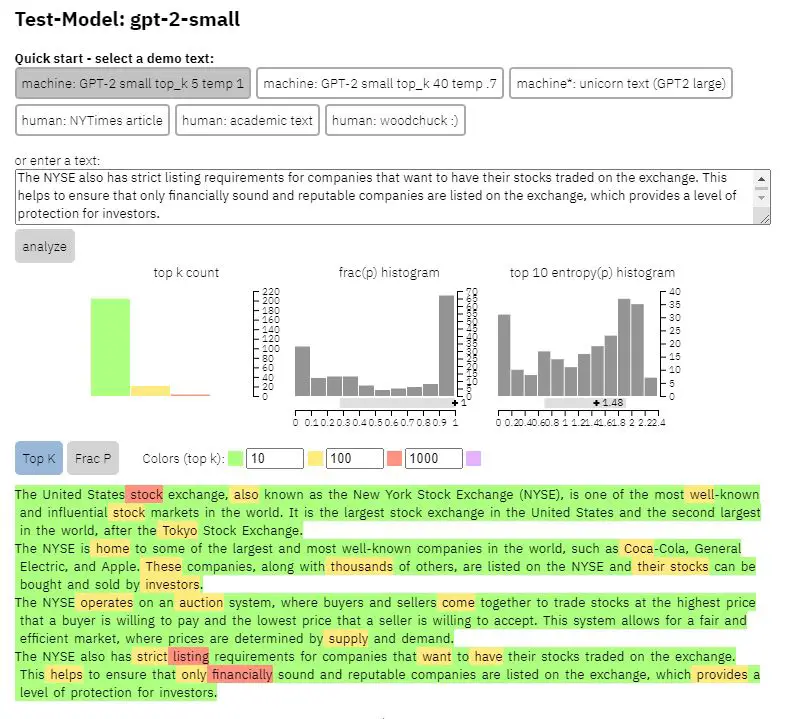
GLTR successfully detected the text is AI generated.
Human text result: ambiguous
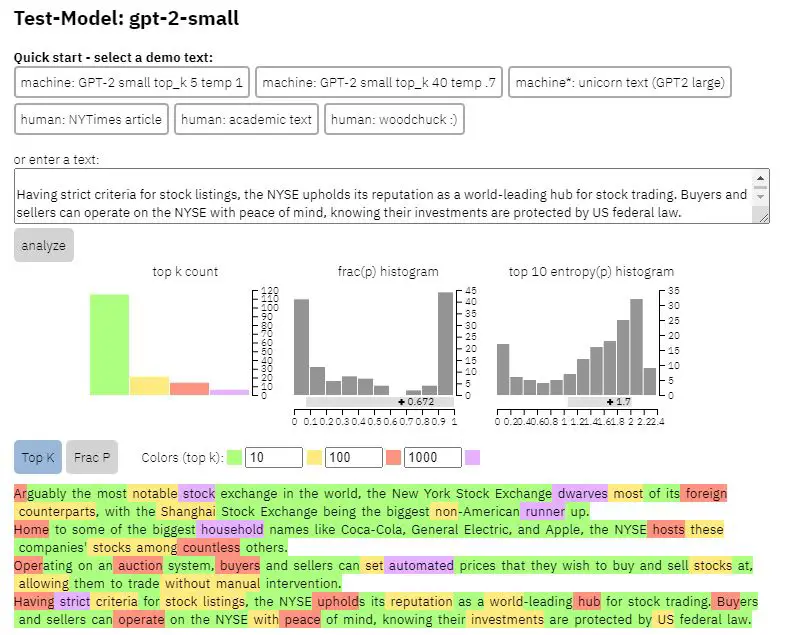
GLTR thinks the human written text is less AI generated but still a lot of green highlights there, indicating it thinks the majority of this text is AI generated.
Originality.ai
Check out our full, in-depth Originality.ai review here.
Originality is among the best content analysers to detect plagiarized and AI-generated material. It uses a combination of the GPT-3 and other natural language models To decide whether or not the material is predictable.
The only AI content recognition technology works well with ChatGPT and GPT 3.5 (the most advanced generative tool).
With a price of $0.01 per 100 words, it is relatively affordable if you need a more robust, industry-level content identification analyser.
Here are some of the notable features of Originality.ai:
- Accurate AI detector – With 94% precision, detect ChatGPT-generated content
- A simple dashboard (works on desktop and mobile)
- My team’s feature for handling big groups
- Supports all popular NLP methods
- Website scan function for website purchasers to determine whether the content is created using AI
- API access – Create unique apps by integrating Originality.ai with other technologies.
AI text result: pass

Human text result: pass

Writer.com’s AI Content Detector
Writer.com’s AI content detector provides you with a human-written ranking between 0-100%.
There is no cost associated with using this tool. Simply paste the copied text into the writer.com text editor and choose to Analyze text to get the results. Next, the software displays the human-written rating in a flash.
The key features include:
- Free AI Content Detection Tool – You may search for AI-generated material for up to 350 words for free.
- Grammar Checker – Check for and automatically repair grammatical problems in your text.
- Plagiarism Checker – Check for plagiarism to ensure your content is unique.
- Integrate Writer with a Google Chrome extension, Google Docs, Microsoft Word, Outlook, and other applications.
AI text result: pass

Human text result: pass
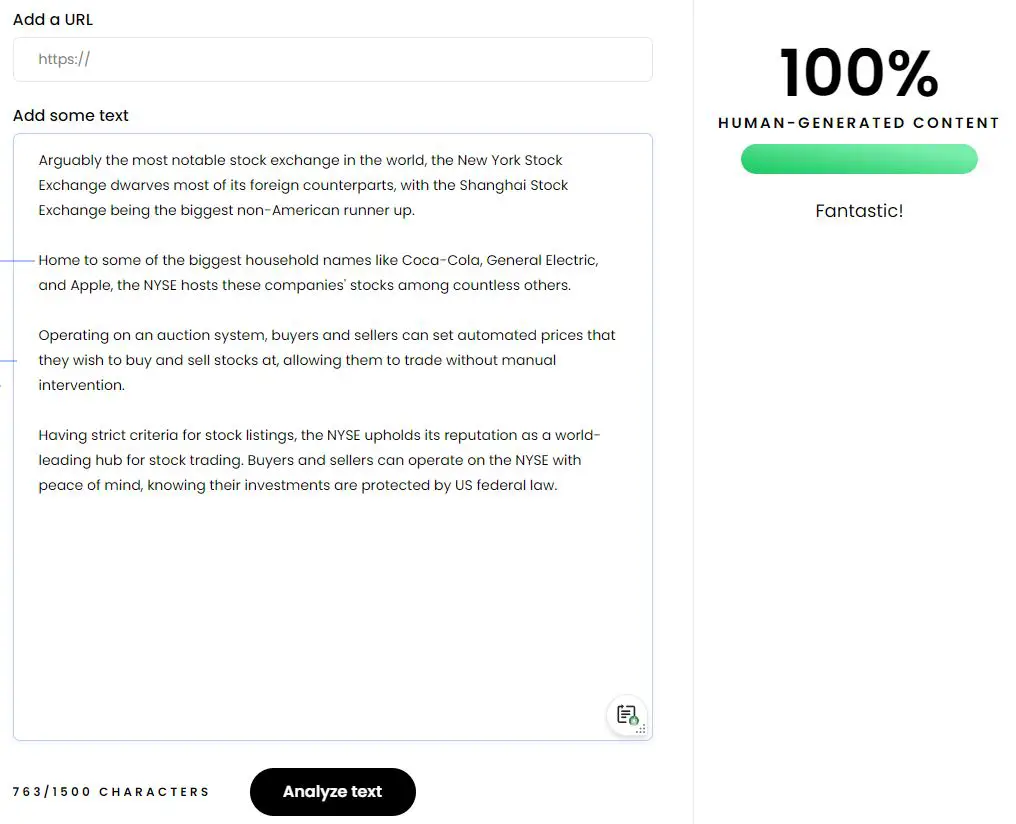
Content at Scale
The AI detection tool offered by Content at Scale is currently the most advanced and effective free AI content detector tool on the market. This free piece of software can identify information generated using bots up to 2,500 characters.
AI text result: pass

Human text result: pass
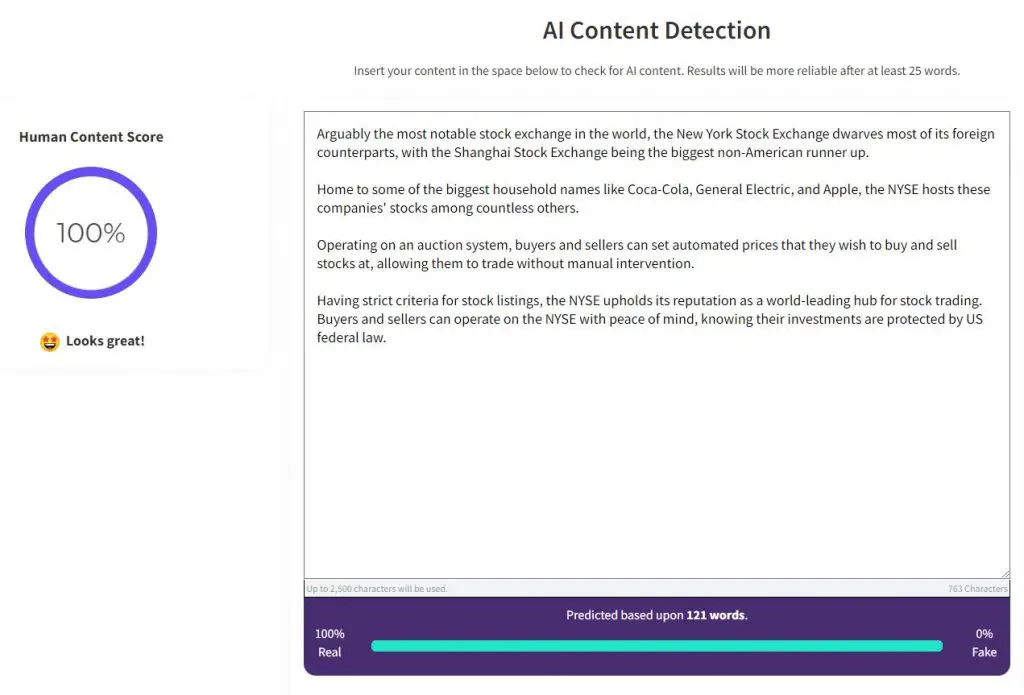
Copyleaks
Another free one, here’s the results from Copyleaks:
AI text result: pass
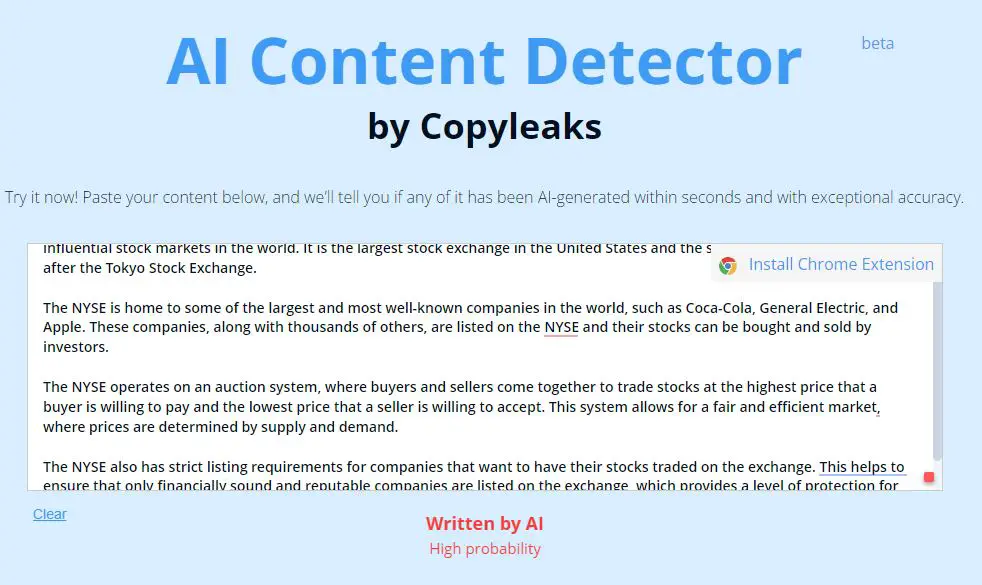
Human text result: pass

How to choose the right AI content detection tool
Understanding the type of content you want to detect is the first step in selecting an AI content detection solution. Specific artificial intelligence content identification tools excel in text, while others work well with visual material like videos or graphics.
When you understand what content you need to detect, you can look into the different detection tools and choose the one that works best for you.
Ease of use, affordability, speed, and accuracy are factors you should consider when comparing various AI content detection programs. One of the most important qualities of a tool is its ability to distinguish between AI and human-authored content effectively.
The speed of a tool is also crucial since it may greatly slow down your productivity if it takes too long to process information. Cost is also a significant consideration since some tools may demand upfront payments or recurring subscriptions to get access.
From our tests, the only premium tool, Originality.ai, wasn’t any better at detecting than the best free tools (Writer.com, Copy at Scale, Copyleaks).
Conclusion
The use of artificial intelligence (AI) to create written content is gaining traction in the marketing, search engine optimisation (SEO), and internet sectors.
It’s a good idea to explore these options and incorporate them into your workflow since checking for originality is likely to become an integral part of the content development process in the future.
Whether or not AI authored an article is not always easy to determine. The rapid rise of the machine learning industry has resulted in the release of more advanced technology in AI, which is a worrying trend.
If these tools can reliably detect whether content is AI generated or not then so there’s no doubt that Google can too. They are, after all, one of the world’s most advanced algorithm companies.
The easiest way to determine whether a computer produced an article is to combine the given tools (probably not GPTZero or GLTR, judging by our tests) and your judgement.
English bloke in Bangkok. First used GPT-3 in 2020 and has generated millions of words with it since. Not really much of an achievement but at least it demonstrates a smidgen of authority. Studies natural language processing, Python and Thai in his spare time.
